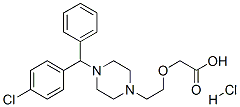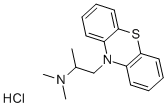Cetirizine dihydrochloride , 98% , 83881-52-1
Synonym(s):
CE;Cetirizine dihydrochloride;CET;CTZ;[2-[4-[(4-Chlorophenyl)phenylmethyl]-1-piperazinyl]ethoxy]acetic acid dihydrochloride
CAS NO.:83881-52-1
Empirical Formula: C21H26Cl2N2O3
Molecular Weight: 425.35
MDL number: MFCD00941428
EINECS: 620-533-8
| Pack Size | Price | Stock | Quantity |
| 1G | RMB91.20 | In Stock |
|
| 5G | RMB171.20 | In Stock |
|
| 25G | RMB413.60 | In Stock |
|
| 100g | RMB1496.00 | In Stock |
|
| others | Enquire |
PRODUCT Properties
| Melting point: | 110-115°C |
| storage temp. | 2-8°C |
| solubility | H2O: soluble5mg/mL, clear |
| form | powder |
| color | white to beige |
| Water Solubility | Soluble in water, DMSO, ethanol, and methanol. |
| Merck | 14,2022 |
| BCS Class | 1,3 |
| Stability: | Hygroscopic |
| InChI | InChI=1S/C21H25ClN2O3.ClH/c22-19-8-6-18(7-9-19)21(17-4-2-1-3-5-17)24-12-10-23(11-13-24)14-15-27-16-20(25)26;/h1-9,21H,10-16H2,(H,25,26);1H |
| InChIKey | PGLIUCLTXOYQMV-UHFFFAOYSA-N |
| SMILES | O=C(COCCN1CCN(C(C2=CC=CC=C2)C2=CC=C(Cl)C=C2)CC1)O.[H]Cl |
| CAS DataBase Reference | 83881-52-1(CAS DataBase Reference) |
| EPA Substance Registry System | Acetic acid, 2-[2-[4-[(4-chlorophenyl)phenylmethyl]-1-piperazinyl]ethoxy]-, hydrochloride (1:2) (83881-52-1) |
Description and Uses
Cetirizine hydrochloride is a once-daily, non-sedating antihistamine useful in the treatment of allergic rhinitis, urticaria and conjunctivitis. It is reported to be more effective than most other agents in this category such as terfenadine and astemizole.
Cetirizine hydrochloride is a nonsedating type histamine H1-receptor antagonist. A major metabolite of Hydroxyzine. Pharmacological activity resides primarily in the (R)-isomer. It is Cetirizine is an antihistamine medicine that is effective in the treatment of allergic rhinitis, chronic urticaria, and pollen-induced asthma. Unlike many traditional antihistamines, it does not cause drowsiness or anticholinergic side effects.
Safety
| Symbol(GHS) |  GHS07 |
| Signal word | Warning |
| Hazard statements | H302 |
| Precautionary statements | P264-P270-P301+P312+P330-P501 |
| Hazard Codes | Xn,Xi |
| Risk Statements | 22-36/37/38 |
| Safety Statements | 26-36 |
| RIDADR | 3249 |
| WGK Germany | 3 |
| RTECS | AG0977500 |
| HazardClass | 6.1(b) |
| PackingGroup | III |
| HS Code | 29339900 |





